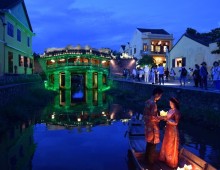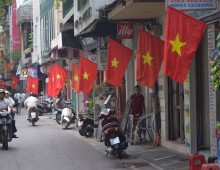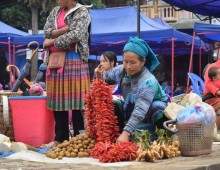From Muang Ngoi in Laos, we wanted to take a boat to Muang Khua which is the gateway to go to Vietnam by a land border. The boat was planned to leave when enough people registered for it! After two days, a boat left with merchandise so we were able to take it. It was a very small wooden boat, with only the boatman and us, sitting on the floor. It took us 6 hours to arrive to Muang Khua. We picked up some people on the way, disembarking some others. The boatman listened to his radio with high volume of traditional Lao music. The landscapes were beautiful, so wild and pure, with only a few bamboo houses hidden in the forest. But we also came across a big building site for a dam built by the Chinese. Indeed they are completely taking over the country, buildings several dams, and a railway.
We were supposed to spend the night in Muang Khua because the bus to the Vietnamese border and Dien Bien Phu was only the next morning (said the tourim information office), but Alex insisted we tried to hitchhike to the border as it was only 2pm and the border is one hour away. So we started to hitchhike but without any success. However, a bus suddently appeared going to Dien Bien Phu!! (looks like it was a Vietnamese bus) So we jumped inside, with a team of friendly Vietnamese people. The bus drove across mountains to arrive to a No-Mans-Land were the Lao immigration office was. We then drove to the Vietnamese office which was even more lost and empty. It looked like the border was not crossed by a lot of people…
We arrived in Dien Bien Phu at night and found a guestouse near the bus station. The bus to Sapa was at 6am the next day, but we decided not to take it and have a day off to visit Dien Bien Phu.
So the next day, we went to the Museum of Victory, relating the victory of Viet Minh over the French with the Dien Bien Phu battle in 1954. The museum was just a collection of artefacts and there was no clear explanation of the battle and the issues at stake. The French were called “agressors” and “malfaitors”. The museum showed that local population was motivated to help the Viet Minh army and care about them, and the Viet Minh appeared to have taken good care of the French prisoners. However, when we completed our knowledge on Wikipedia, it appeared that amongst the 11000 French prisoners, only 3000 survived from the Viet Minh, and actually the local tribes were so afraid of the Viet Minh that they were forced to help them… which made us realize that all the museum was only propaganda!
When going to the museum, we also ended up in a huge market full with local life.
Apart from the museum, there is a victory monument, but nothing else… We felt a bit down on our last evening in Dien Bien Phu, missing our friends and family, and not feeling welcomed anymore. That is when we met two Vietnamese policemen! As we were going back to the restaurant we had been visiting for two days to have dinner, a man approached us and invited us to join him and his friend at their table. We accepted, a bit suspicious, but we ended up spending a memorable dinner with them. They offered us a shot of rice wine, wished us happiness, cheered, drank, shook hands, and started again and again while eating food! They were two policemen, dressed of civilians, living in Dien Bien Phu and communicating with us through Google Translate. They shared their food with us and even paid for our food at the end. This is the good memory we will keep from Dien Bien Phu!




I had the same feeling as you about Dien Bien Phu, until we got to play football with some local kids 🙂
Haha nice!! It is in those times that you realize how the contact with local people can totally change the perception we have of a country or a city!